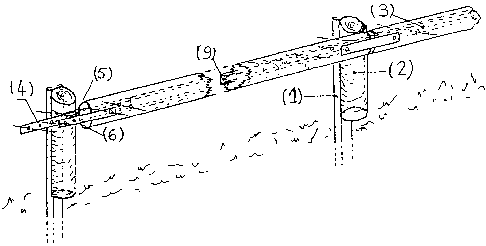Some of the information on this Web page has been provided by external sources. The Government of Canada is not responsible for the accuracy, reliability or currency of the information supplied by external sources. Users wishing to rely upon this information should consult directly with the source of the information. Content provided by external sources is not subject to official languages, privacy and accessibility requirements.
Any discrepancies in the text and image of the Claims and Abstract are due to differing posting times. Text of the Claims and Abstract are posted:
| (12) Patent: | (11) CA 2094967 |
|---|---|
| (54) English Title: | COMPOSITE ROAD SAFETY SLIP RAILS MADE FROM METAL AND REINFORCED ROUND WOOD AND THEIR METHODS OF MANUFACTURE |
| (54) French Title: | GLISSIERES DE SECURITE COMPOSITES FABRIQUEES AVEC DES PIECES METALLIQUES ET DE BOIS RONDES, ET METHODE DE FABRICATION |
| Status: | Expired and beyond the Period of Reversal |
| (51) International Patent Classification (IPC): |
|
|---|---|
| (72) Inventors : |
|
| (73) Owners : |
|
| (71) Applicants : |
|
| (74) Agent: | OSLER, HOSKIN & HARCOURT LLP |
| (74) Associate agent: | |
| (45) Issued: | 2001-08-28 |
| (22) Filed Date: | 1993-04-27 |
| (41) Open to Public Inspection: | 1993-10-31 |
| Examination requested: | 2000-02-09 |
| Availability of licence: | N/A |
| Dedicated to the Public: | N/A |
| (25) Language of filing: | English |
| Patent Cooperation Treaty (PCT): | No |
|---|
| (30) Application Priority Data: | ||||||
|---|---|---|---|---|---|---|
|
Composite slip rails for road safety made from round wooden bars reinforced
with iron and comprising posts made from sectional iron and supporting each
one a
spacer carrying a horizontal guard rail consisting of previously slotted round
wooden beams reinforced with embedded metal fishplates providing for the
cohesion of the wood and the connection of the elements.
Note: Claims are shown in the official language in which they were submitted.
Note: Descriptions are shown in the official language in which they were submitted.

2024-08-01:As part of the Next Generation Patents (NGP) transition, the Canadian Patents Database (CPD) now contains a more detailed Event History, which replicates the Event Log of our new back-office solution.
Please note that "Inactive:" events refers to events no longer in use in our new back-office solution.
For a clearer understanding of the status of the application/patent presented on this page, the site Disclaimer , as well as the definitions for Patent , Event History , Maintenance Fee and Payment History should be consulted.
| Description | Date |
|---|---|
| Inactive: Agents merged | 2013-10-16 |
| Inactive: Reversal of expired status | 2013-10-09 |
| Time Limit for Reversal Expired | 2013-04-29 |
| Letter Sent | 2012-04-27 |
| Inactive: IPC from MCD | 2006-03-11 |
| Grant by Issuance | 2001-08-28 |
| Inactive: Cover page published | 2001-08-27 |
| Pre-grant | 2001-05-23 |
| Inactive: Final fee received | 2001-05-23 |
| Notice of Allowance is Issued | 2001-02-27 |
| Notice of Allowance is Issued | 2001-02-27 |
| Letter Sent | 2001-02-27 |
| Inactive: Approved for allowance (AFA) | 2001-01-29 |
| Amendment Received - Voluntary Amendment | 2001-01-11 |
| Inactive: S.30(2) Rules - Examiner requisition | 2000-10-30 |
| Inactive: Application prosecuted on TS as of Log entry date | 2000-03-09 |
| Letter Sent | 2000-03-09 |
| Inactive: Status info is complete as of Log entry date | 2000-03-09 |
| Request for Examination Requirements Determined Compliant | 2000-02-09 |
| All Requirements for Examination Determined Compliant | 2000-02-09 |
| Application Published (Open to Public Inspection) | 1993-10-31 |
| Small Entity Declaration Determined Compliant | 1993-04-27 |
There is no abandonment history.
The last payment was received on 2001-04-23
Note : If the full payment has not been received on or before the date indicated, a further fee may be required which may be one of the following
Patent fees are adjusted on the 1st of January every year. The amounts above are the current amounts if received by December 31 of the current year.
Please refer to the CIPO
Patent Fees
web page to see all current fee amounts.
| Fee Type | Anniversary Year | Due Date | Paid Date |
|---|---|---|---|
| MF (application, 5th anniv.) - small | 05 | 1998-04-27 | 1998-03-24 |
| MF (application, 6th anniv.) - small | 06 | 1999-04-27 | 1999-03-24 |
| Request for examination - small | 2000-02-09 | ||
| MF (application, 7th anniv.) - small | 07 | 2000-04-27 | 2000-04-03 |
| MF (application, 8th anniv.) - small | 08 | 2001-04-27 | 2001-04-23 |
| Final fee - small | 2001-05-23 | ||
| MF (patent, 9th anniv.) - small | 2002-04-29 | 2002-04-19 | |
| MF (patent, 10th anniv.) - small | 2003-04-28 | 2003-04-15 | |
| 2004-04-16 | |||
| MF (patent, 11th anniv.) - small | 2004-04-27 | 2004-04-16 | |
| MF (patent, 12th anniv.) - small | 2005-04-27 | 2005-04-25 | |
| 2006-04-25 | |||
| MF (patent, 13th anniv.) - small | 2006-04-27 | 2006-04-25 | |
| MF (patent, 14th anniv.) - small | 2007-04-27 | 2007-04-12 | |
| MF (patent, 15th anniv.) - standard | 2008-04-28 | 2008-04-25 | |
| MF (patent, 16th anniv.) - small | 2009-04-27 | 2009-04-21 | |
| MF (patent, 17th anniv.) - small | 2010-04-27 | 2010-04-22 | |
| MF (patent, 18th anniv.) - small | 2011-04-27 | 2011-04-17 |
Note: Records showing the ownership history in alphabetical order.
| Current Owners on Record |
|---|
| DANIEL DUYCK |
| JACQUES DE MAUSSION |
| Past Owners on Record |
|---|
| None |